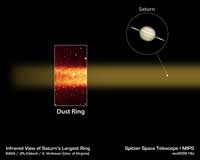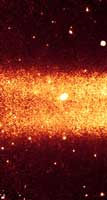|
COMETS EARTH JUPITER KUIPER BELT MARS MERCURY METEORITES NEPTUNE OORT CLOUD PLUTO SATURN SOLAR SYSTEM SPACE SUN URANUS VENUS ORDER PRINTS
PHOTO CATEGORIES SCIENCEVIEWS AMERICAN INDIAN AMPHIBIANS BIRDS BUGS FINE ART FOSSILS THE ISLANDS HISTORICAL PHOTOS MAMMALS OTHER PARKS PLANTS RELIGIOUS REPTILES SCIENCEVIEWS PRINTS
|
Related Documents
Download Options

Figure 1 Click on the image for larger version This picture highlights a slice of Saturn's largest ring. The ring (red band in Figure 1) was discovered by NASA's Spitzer Space Telescope, which detected infrared light, or heat, from the dusty ring material. Spitzer viewed the ring edge-on from its Earth-trailing orbit around the sun. The ring has a diameter equivalent to 300 Saturns lined up side to side. And it's thick too -- about 20 Saturns could fit into its vertical height. The ring is tilted about 27 degrees from Saturn's main ring plane. The Spitzer data were taken by its multiband imaging photometer and show infrared light with a wavelength of 24 microns. The picture of Saturn was taken by NASA's Hubble Space Telescope. |
